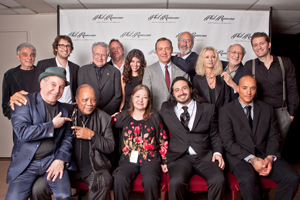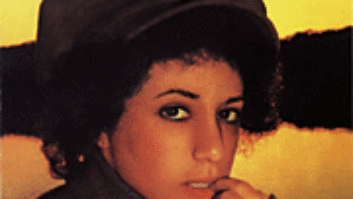
Saturday night saw a remarkable collection of artists, peers, friends and family gather to remember a recording industry legend at the Phil Ramone Music Memorial Celebration in New York City. The noted producer, who won 14 Grammy awards, was nominated 33 times and had career album sales well over 100 million, passed away on March 30, 2013 at the age of 79. The private event saw heartfelt remembrances and performances by the likes of Billy Joel, Tony Bennett, Quincy Jones, Paul Simon, Kevin Spacey, Josh Groban, Dave Grusin, Shelby Lynne, engineer Ed Cherney, Matthew Morrison, Noel Paul Stookey and Peter Yarrow of Peter, Paul & Mary, and Nikki Yanofsky.
The evening, held by the Ramone family within the art deco auditorium of the Salvation Army’s Greater New York Division Headquarters, kicked off with an audio recording of the future producer as a 16-year-old violin prodigy, performing on Ted Mack and the Original Amateur Hour. That was soon followed by The Salvation Army Phil Ramone Orchestra for Children, a program the producer founded in November, 2011 to provide music education for 7-12-year-olds in challenged communities.
Then the cavalcade of recollections from those who knew him best—family, associates, artists and others—began. Throughout the night, the breadth of Ramone’s work was explored, discussing his impact on concert sound (Barbra Streisand and Simon & Garfunkel’s Central Park concerts), film (Midnight Cowboy, Flashdance and Reds among others), TV (numerous awards shows) and history itself (Ramone designed the Presidential Oval Office recording system that became such a prominent part of Nixon’s Watergate scandal).
However, most presenters spent their time remembering the mentor who knew how to draw the best out of them, calm their escalating artistic nerves and provide a guiding hand when needed.
Billy Joel:
The longest recording project we did together was an album in 1982 called The Nylon Curtain. Phil actually turned the studio into an instrument. I don’t know how he did it but sonically, he created arrangements and songs out of nothing. We didn’t know what it was until the final mix, but he knew what he was doing. I wasn’t always sure what he was doing, but it ended up being exactly what I wanted it to be.
When we got to almost the end of the recording process, he wanted me to write another song. He says, “This needs an epilogue, because this is like an American novel; you have to write an epilogue.” And I went to another studio, I wrote down some words, played the piano and I came back with an idea for a song—which I thought was hardly even finished.
I played it for him and he said “That’s it! That’s the song!” And I said, “Yeah, but there’s something like 30 lines and there’s only three rhymes.”
He goes, “So what?”
And I thought, “Wow. It never occurred to me: So what?” Phil Ramone said “So what?”—which made it totally OK!
To hell with the rhyme. I like the song, it works, do it.
And ever since Phil passed away, this song has been running around and around in my head and I can’t shake it, so I’m going to play it for you. It’s called “Where’s The Orchestra?”
Tony Bennett:
Most entertainers dislike producers; right away, they start telling you what you shouldn’t do. You walk in very enthusiastic and come up with something that’s original and different—and they say “We’re not doing that anymore.” The opposite was the beautiful gentleman, Phil Ramone.
He did the last two albums that I’ve recorded and both of them sold millions of records. I can’t tell you how comfortable he made me feel and he was just, he fell in love with my son, Dae, who is my sound engineer, and Danny my manager, my two sons, and we spent quite a few weeks making the albums. I can’t tell you how much of family he was to me—and how much he loved his family. I never met a more sane man than Mr. Ramone. There’ll never be another one like him. He was the best producer—I’ve had a lot of them in my career.
Dave Grusin:
I’ve never found anybody in this business with better ears. He was also the very definition of mentor in terms of his vision and kindness. He always had a way of making us feel like everything was going to be OK.
We worked together on a DVD I did more years ago than I care to remember; it was the 40th anniversary of West Side Story, and it was just another example of pure joy working with this guy. There was a sense that Phil was always there, and I still feel that way—I get a sense that if I get in trouble, he’ll tell me what to do.
Noel Paul Stookey:
He never missed a trick and I have to tell you, personally, one of the most beautiful things that I own is a scrap of paper from when we recorded Lifelines. He walked by me in the studio, didn’t say a word, but this was Phil’s way: He stuck a piece of paper in my pocket. When I got back to the hotel room from doing the session that day, I opened it and it said, “I love your work, man.”
I put that in a 5×7” frame and it is still there.
Ed Cherney:
We’d been friends for 25 years, and for some reason, he never hired me. I always heard about him being with Al Schmitt and with Elliot Scheiner or Frank Filipetti, and I’m thinking, “What am I? Chopped liver?” Then one day a year ago, the phone rings and it’s Phil. He goes, “So, Ed—you want to engineer for me a couple of records?” Actually, he said, “You want—“ and I went “OK!”
So he hired me, and the dates were for a Matthew Morrison record, and another one, for Alejandro Fernandez, and I was so excited when I hung up the phone, I was jumping around, I called up my wife Rose—“Phil called, I’m gonna engineer for him!”
I hung up the phone and started thinking about it…and started thinking of ways to get out of it, call him up and go “Oh man, eeeehhhhhaaaa.” Because you want that Phil Ramone Stamp of Approval, and what if I failed? I’d have to go into the witness protection program—I’m through. And I’m thinking of ways to call him up—I’m not the right guy—but I couldn’t do it. Eventually the date came, and I couldn’t sleep much the night before; I think I got to the studio six hours early. The musicians came, we set up, they let me get sounds and I was deadly serious…and being serious isn’t always the easiest thing for me.
We did the first take, the musicians came in for the first playback, and Phil rolled up next to me in that voice that’s part of my DNA now, said “Sounds great, darling…BUT DON’T TOUCH THAT ——- MONITOR POT!” So we were alright.
Kevin Spacey, on recording as Bobby Darin for the Beyond The Sea soundtrack:
I remember we’re at Abbey Road—and Abbey Road is Abbey Road, right? The Beatles have recorded all their songs there and other extraordinary artists and I’m standing there in front of a 72-piece orchestra and I’m doing this particular number that I’m about to do.
We did one take and it didn’t go well; we did a second take and it didn’t go well, and Phil said, “Ah, I’m going to come down.”
So he climbed down the stairs.
And he came over to me and he said, “Listen. The song’s not that hard.”
I said, “Yeah…”
And he said, “Look, why don’t you change the way you’re thinking about it? Just relax and imagine you’re not here, and you’re not where you are. We’re just at a little nightclub, just you and me hanging out like a couple of friends. Just imagine you’re at Jilly’s.”
I said, “Well that’s great, Phil, but Sinatra would have never have let Bobby Darin in Jilly’s!”
He said, “Alright. We’ll call it Philly’s.”
So I’d like you all to calm down, hang out and imagine we’re all in a little place called Philly’s.
BJ Ramone
My dad had a lot of firsts, from using fiber optics to record Frank Sinatra’s Duets from one end of the country to the other, to remastering Billy Joel’s 52nd Street album to be the first commercially released CD. He was always a visionary, embracing new technology. I wouldn’t be surprised if that big storm today was him—he found some technological way to come out and be theatrical—“Here I am, thunder and lightning.”
He was especially proud to be part of the Grammy team, and that produced the first network broadcast in HD, live 5.1 surround. Years earlier, his work for concert sound production for Barbra Streisand and Simon & Garfunkel in Central Park pioneered concert sound for massive audiences.
This isn’t to say he didn’t employ low-tech methods to achieve brilliance. When he needed the sound of shattering glass for one of Billy’s songs, he threw five-gallon drinking jugs down the back stairwell. That was pretty amazing—but when that didn’t work, he switched to smashing large pieces of glass in the studio with a sledgehammer, which I can only imagine was pretty awesome.
In Brazil with Paul [Simon], after hearing a local marching band, he swung microphones over tree branches to record them in the town square. When he needed power, someone handed him live wires they’d pulled from a manhole. Hey, whatever works.
All of which is to say that my dad lived the old maxim: if there’s a will, there’s a way.
Performances across the evening included “When the Saints Come Marching In” by The Salvation Army Phil Ramone Orchestra for Children, while Billy Joel performed “Where’s the Orchestra”; Tony Bennett sang “Fly Me To The Moon”; keyboardist/composer Dave Grusin performed “Sun Song”; Peter Yarrow and Noel Paul Stookey (Peter, Paul and Mary) performed “Day Is Done”; Shelby Lynne performed “You Don’t Have to Say You Love Me”; Kevin Spacey performed a medley of “By Myself,” ”When Your Lover Has Gone” and “The Curtain Falls”; Nikki Yanofsky performed “You’ll Have to Swing It (Mr. Paganini)”; Matthew Morrison performed a medley that included “Come Rain Or Come Shine” and ”Basin Street Blues”; Paul Simon provided renditions of “Slip Slidin’ Away” and “Fifty Ways to Leave Your Lover”; and Josh Groban closed out the evening with “Smile.”
The event was recorded for the family by Music Mix Mobile (M3) on an Avid Pro Tools HDX system. “We have two other shows going on right now—we have an upfront for NBC and another show—but it [matters to us to be here],” said Joel Singer of M3. “We want this to be right and archived properly, not that there’s anything planned for it. That’s what we used to do with Phil—we used to go in and document things that needed to be documented. Phil was such an avid supporter of the Songwriters’ Hall Of Fame and getting that documented every year; a lot of times, he did it out of his own pocket, because he wanted to get it done.”
The in-house PA was augmented with gear provided by Firehouse Productions, which provided Yamaha PM5D consoles used by FOH engineer Ron Reaves and monitor engineer Jim Hores, as well as groundstacked JBL VerTec line arrays to supplement the house Meyer system. Clair provided backline for the house band, while BML Blackbird provided supplemental lighting.
“Everyone’s donated time and gear—no one’s taking a penny for this,” noted Singer. “It’s all being done for the love of the man.”







